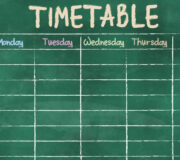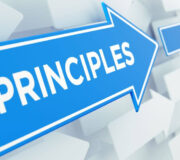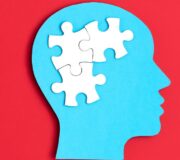EEF Digital Technology Report 2019 [SLT Summary]: Essential Guidance For School Leaders On The Perils And Promises Of EdTech In The UK
Using Digital Technology to Improve Learning is a new 2019 EEF Guidance Report which offers some key guidance and advice for primary school leaders and headteachers on how to plan for, evaluate, and assess the benefit of the educational and digital technology in your school.
It’s a must read but a long read for anyone interested in Edtech in the UK; unlike many other reports about digital technology in education, it includes lots of practical evidence and examples from the classroom.
This is not another glossy brochure full of promises that don’t deliver!
If you’re not sure who the EEF is or what they do your first port of call should be their teaching and learning toolkit here.
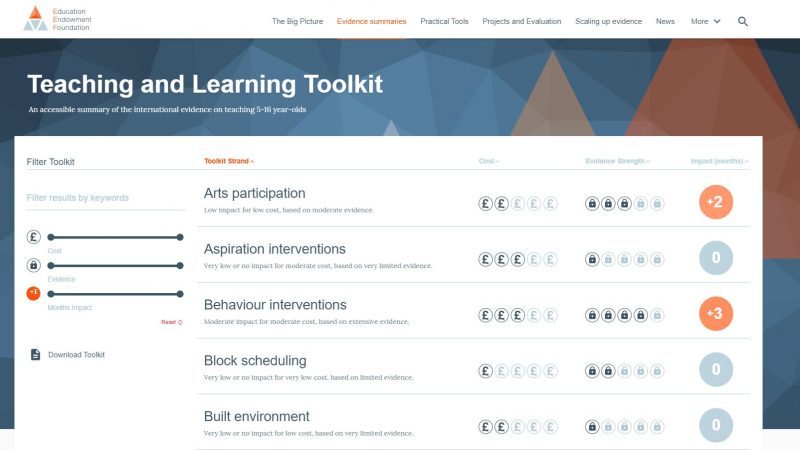
Funded by Nesta and the Sutton Trust. they undertake robust efficacy trials into what works in UK education; their results are summarised on the toolkit and several other influential EEF reports and guidance documents or pdfs.
So, to save you time and having to read the full report, the following is a summary of the EEF guidance report, together with some practical tips for how you can make the best use of Edtech in your school.
How To Do A Technology Audit In Your School
Download our free classroom technology audit checklists and find out more about the technology that is being used in your school!
What Counts As Edtech Or Digital Technology In Education?
In the UK what we tend to think of as Edtech or digital technology spans everything from creating a history presentation on PowerPoint, through to using your phone as a calculator, and even to a Virtual Reality immersive visit to the Amazon Rainforest.
With such a vast and varied Edtech landscape on show in the UK, to help you out and give you an idea of some of the things that count as Edtech, here is a list of some of the pieces of technology you may recognise, that has been used in schools in 2019:
Edtech In UK Schools 2019 – Hardware And Software
Hardware
- Interactive whiteboards or visualisers
- Computers, laptops and tablets
- Clickers / voters
- The Raspberry Pi
Software / Apps
- Text messages / parenting apps to influence learners
- Online learning environments like SeeSaw and Flipgrid
- Reading, writing or numeracy apps
- Longer term online programmes
- Technology to enhance teaching such as online tuition platforms
- Podcasting software (and the hardware that goes with it)
- Online games – both those made for education and those adapted by educators
- MS Office Suite or Google Edu
I could go on…
The list is as endless as the shiny pieces of kit decorating the hundreds of stands at the Excel Centre at BETT each year, and to find out a little more about what happened at BETT in 2019, take a look here.
The EEF digital technology report however makes it clear that all their findings are based very much on their most secure trials with ‘technology inputs’ within those that make up their teaching and learning toolkit.
Digital Technology In The Classroom In 2019
Digital technology is irrefutably a part of the lives of every child we teach.
Nowadays, pupils do not remember a time when digital devices were scarce – these young people coexist with technology in a way that, even now, most teachers cannot fully relate to.
But there are some very tech-savvy teachers – indeed, most adults these days are very ‘connected’ – and technology in education, or Edtech as it is often referred to, isn’t even a new thing anymore.
I, for example, remember the introduction of the BBC computer and how excited we all were to play on it when it was wheeled into our classroom on its trolley!
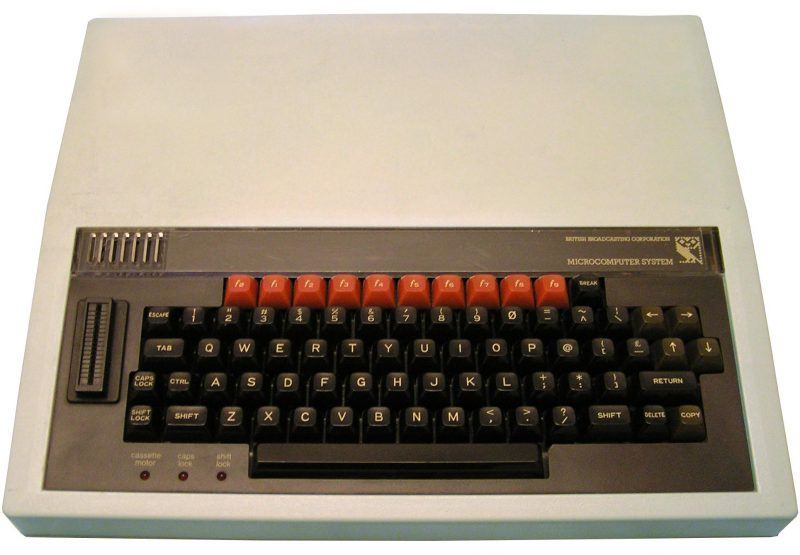
There will be pieces of technology that we all remember being introduced into the classroom to gasps of amazement, as you’ll recall if you read our brief history of Edtech in the classroom.
However, Edtech is so commonplace nowadays that if this blog were to be written again in even 10 years’ time, it would probably be as long as War and Peace!
How You Can Find Your Way Through The Edtech Marketing Minefield
Everyone now knows that Edtech isn’t a new thing. There are:
- endless innovations;
- endless marketing emails encouraging teachers to adopt a new device-based way of teaching;
- and endless promises of academic progress if only schools would sign up to the latest e-learning platform.
It can be a minefield to say the least – one that some are more than happy to navigate, but also one that some won’t even take a risk with.
The EEF’s latest guidance report, simply named Using Digital Technology To Improve Learning, is a great starting point for any school leader or teacher who is questioning whether or not a particular digital technology will be worth the (often expensive) investment.
The 4 Main Recommendations From The EEF Digital Technology Report
The easy-to-use booklet has four main recommendations:
- Consider how technology is going to improve teaching and learning before introducing it.
- Technology can be used to improve the quality of explanations and modelling.
- Technology offers ways to improve the impact of pupil practice.
- Technology can play a role in improving assessment and feedback.
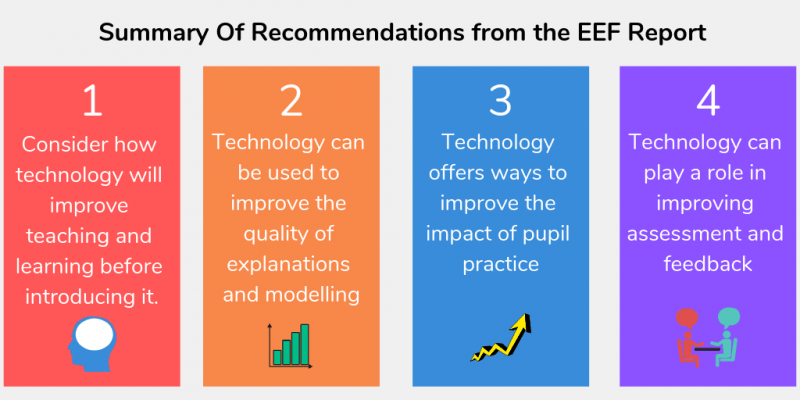
What This Edtech Report Can’t Offer You
If you are looking for research-based advice on the teaching of computing or coding, or on questions related to screen time or the use of mobile devices, then this report isn’t the one for you.
Instead, the report focuses on helping schools to consider how they can use digital technology within education to improve pupils’ learning.
So, without further ado, let’s take a closer look at the recommendations:
Recommendation 1: Consider How Technology Is Going To Improve Teaching And Learning Before Introducing It
My favourite part of the whole report are these sentences:
‘New technology can often appear exciting. However, it can become a solution in search of a problem unless it is introduced in response to an identified need.’
The report makes it very clear that we shouldn’t be using technology in schools for the sake of it – rather there should be a real problem that might be solved with the use of digital technology.
The report tells of an interesting evaluation that the EEF carried out on a digital technology programme to improve literacy.
In the trial conducted, they converted all the digital materials into pen-and-paper resources and also tested the efficacy of those: pupils in both the digital and non-digital groups made similar amounts of progress with both groups making greater progress than pupils in the control group.
This trial points us towards the question asked in the report itself: is technology the active ingredient?
Digital + Pedagogy = Good Results
A well-designed digital programme with good pedagogy at its heart will probably be a success in the classroom.
But would a non-digital counterpart do the trick just as well?
That is definitely something we all must consider.
However to counter this, it is worth considering, when thinking about employing a digital programme, how the technology might make things easier.
Self-marking activities, automated feedback to students and online reports of automatically gathered data, for example, remove a certain burden from teachers thus freeing them up for more teaching and learning.
Third Space Learning is a good example of this, with the online reporting for their intervention sessions saving teachers/teaching assistants time and having to write up what has happened in the sessions (and the opportunities to peer or class mark during class time thanks to the structure of TSL’s ready-to-go lesson slides).
This recommendation, out of the four discussed in the EEF report, might just be the most important, although the remaining three provide lenses through which to evaluate any potential Edtech projects before handing over the cash and making any commitments.
What You Can Do Based On This Recommendation From The EEF Digital Technology Report
It is never too late to assess something retrospectively and make the necessary changes. Therefore you can:
- Ask yourself whether or not the digital technologies you currently employ or are planning to buy are a solution to a problem, or whether they were just the latest must-have gimmick which the person holding the ICT budget fancied having a play with.
- Consider whether your new Edtech will substitute, augment, modify or redefine (the SAMR Model) existing teaching and learning methods. Read this blog post on how to do a school technology audit for further guidance on this, and see how you can generate your own Edtech report.
- Monitor your use of digital technologies. If you have put something in place, but haven’t really assessed its impact so far, then why not evaluate its success thus far? The EEF’s guidance report on implementation will be a useful tool when doing this.
- Speak to staff and children about how they are using the digital technologies you currently have. If they can testify that the programmes you have are fulfilling the following recommendations then you may have something good on your hands.
- Before taking on any new digital technology, follow the same principles you would for any intervention – look at who it’s for, what the reason is, and whether it’s actually just replacing a viable non-tech alternative. Read this checklist for advice on how to choose your next intervention.
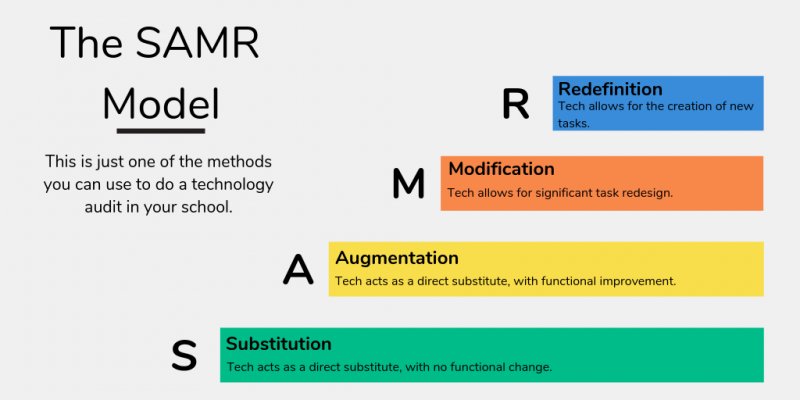
How This Works For Schools With Third Space Learning
Our aim when speaking to schools about our online 1-to-1 maths tuition is to be as straightforward as possible.
For us, our technology is a core component of what we do, but it’s not what we provide to schools.
It is instead the vehicle through which we are able to provide schools with access to high quality intervention teaching for a larger number of their pupils.
The response schools get when they ask pupils for their feedback on this Edtech is generally an ecstatic one. I mean which child doesn’t love the chance to use tech at school! That said the online environment doesn’t work for all pupils, and it is very dependent on both the pupil and the technology being used.
Find out how Third Space can support your pupils to make double expected progress
Recommendation 2: Technology Can Be Used To Improve The Quality Of Explanations And Modelling
Recommendations 2-4 focus on well-established, evidence-based tenets of teaching: elements or principles of pedagogy that should ensure that children are actually learning.
If technology is to be used during the modelling stage of teaching, then it should improve and enhance it. The improvement could come in a number of forms:
- It could be easier for the teacher to model
- It could make it easier for the child to understand the modelling
- It could be live modelling or a pre-prepared model
There are two obvious and major caveats here:
- The technology must function correctly in order to ensure the improved quality of explanations and modelling.
- Teachers must be familiar enough with the technology to actually make best use of it, as so often it comes down to quality training / CPD.
It’s all very well having the latest interactive whiteboard, but if a teacher hasn’t been trained on how to use all its bells and whistles it is little different to a blackboard and chalk. To add to this, if the technician still hasn’t been to make sure that it’s actually interactive then it’s little more than a white surface to project onto.
Training And Support Is Essential – Without It Digital Technologies Will Most Likely Be Ineffective
The report highlights several areas where explanations and modelling might actually be enhanced by digital technology, simulations in science and mathematics for example.
Although it also points out that these are even more effective when used to support hands-on learning and real modelling.
A message that is evident throughout the report is that digital technology should not stand alone in the classroom, rather it should be used to enhance standard classroom practice.
What You Can Do Based On This Recommendation From The EEF Digital Technology Report:
- Think about whether or not your technology offers something more than alternative, non-technology-based options. If it enhances learning, keep using it, but if it doesn’t offer anything more, make sure that you are not spending unnecessary time, effort and money on it.
- Assess how digital technologies supplement and support the rest of the teaching and learning that is taking place – ensure that teachers are not relying solely on technology, but that it is one tool in their repertoire.
- If quality of explanations and modelling are an issue in your school, consider how digital technology might improve this. Simple solutions such as training on how to use the interactive whiteboard software to its full potential, or the introduction of visualisers (and training about their uses) could revolutionise the way teachers teach.
How This Works For Schools With Third Space Learning
We know that one of the principal reasons schools use our 1-to-1 tutors is because they are trained professionals, expert in teaching primary school maths.
Not all intervention leaders are however, so to support those with less confidence in modelling and explanations we’ve combined the technology of video explanations with our online library of maths resources.
The result is a collection of over 200 CPD videos that model everything from using Playdough to understand what half is through to working out complex ratio problems with a bar model.
Find out more about the Third Space Learning online Maths Hub of maths resources.
Recommendation 3: Technology Offers Ways To Improve The Impact Of Pupil Practice
Once teachers have modelled and explained the work, children must then practice what they have been taught – no one would argue with this.
Digital technologies can provide ways to enhance this type of practice.
Under this recommendation the report warns against the belief that the use of digital technologies will automatically improve motivation, increase engagement and therefore lead to achievement.
There needs to be a baseline level of computer and self knowledge, and the skills to be able to make the most of some digital technologies.
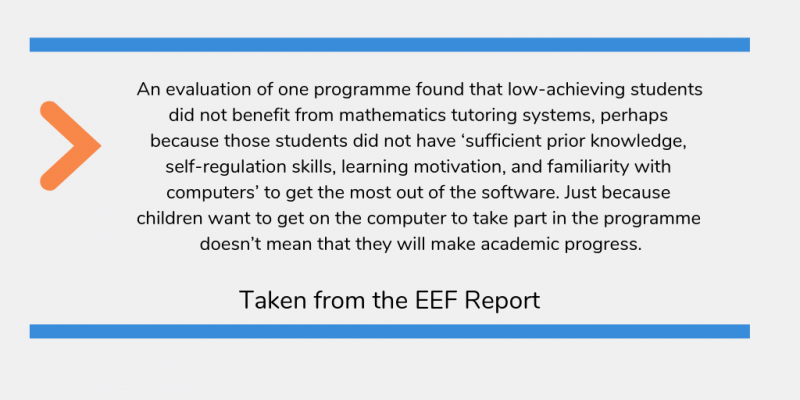
This section of the document also comments on adaptive technologies: programmes which automatically assess children as they work and adapt the work which follows in order to support or challenge the child.
The results have been ambivalent to say the least – some studies have found these programmes less effective whereas others have found them to be more effective.
The impact of digital technology in education depends on a number of other factors.
The health warning here is that programmes must be carefully chosen, implemented and monitored to ensure that they are having the desired effect.
What You Can Do Based On This Recommendation From The EEF Digital Technology Report:
- Question children about what they like and dislike about the digital technologies that they use when learning.
Find out about how they feel with regards to motivation, engagement and achievement – if they are unsure about whether or not they are achieving anything by using it then this may be an indicator that change needs to take place.
On the other hand, if they can attest to improving something, say their times tables knowledge, through use of digital technologies, and can prove it, then you have good grounds for its continued use. - Think about how the principles of practice that many programmes use might be employed when children are learning non-digitally. There is plenty of information available about the benefits of practice and the testing effect which teachers can access to improve their understanding of how we learn. Clare Sealy wrote a fantastic series of blogs, one of which was all about retrieval practice which is a good place to begin on this topic.
How This Works For Schools With Third Space Learning
We believe that digital technology on its own isn’t enough which is why our programme of digital lessons is always delivered by a trained, 1-to-1 maths expert.
Embedded into our pedagogy are the tools to increase motivation, engagement and, most importantly, self knowledge and metacognition.
An adaptive diagnostic assessment gives us a good understanding of a child’s gaps in maths, and we then seek to plug these gaps and develop learning through a mix of direct instruction, encouragement and incentives for effort, as well as additional challenges to build resilience where necessary.
None of these steps would be possible with digital technology alone, and that is why we’ve taken great care to merge maths experts with the technology that is available today to help pupils get the perfect balance between the two in their learning.
If you would like to see just how much of an impact Third Space Learning’s 1-to-1 maths interventions could have on not only your pupil’s attainment, but also their confidence, motivation and engagement, then learn more about what we can do for you here.
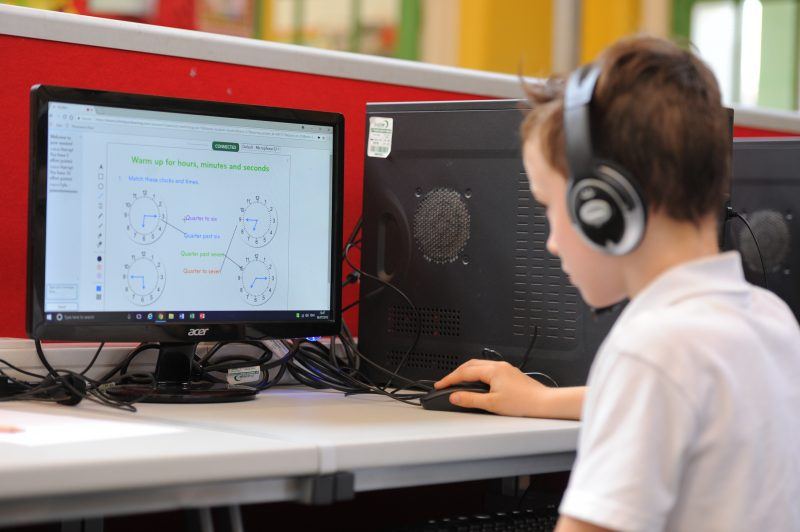
Recommendation 4: Technology Can Play A Role In Improving Assessment And Feedback
As already mentioned, digital programmes can provide a wealth of information to teachers about children’s progress. But, as with any data, it is only useful when it is used to inform future teaching and learning.
Some of the EEF’s evaluations of digital learning programmes have also found that:
‘effective use of software also often still relies on some support from teaching staff, even if just to encourage pupils to concentrate on it. There is evidence that guidance from a teacher or teaching assistant can make the impact greater than it would have been otherwise’.
Digital technologies on their own are probably not the whole answer: teachers and leaders should be wary of putting all their hopes on a bought-in device-based programme, and put a focus on finding a balance between human and technology.
What You Can Do Based On This Recommendation From The EEF Digital Technology Report:
- Make sure that assessment data provided by any programmes you currently use is accessed and made use of.
This feedback to teachers and children could ensure that future learning is targeted and finely tuned to the needs of the children. - Evaluate the balance in the use of digital technologies and other teaching methods – if there is a programme that solves a current problem, introduce it; if there are programmes currently in use which are being relied on too heavily and which are not linked to classroom practice, consider how the use of these might be altered.
How This Works For Schools With Third Space Learning
As the report states, most Edtech in schools comes with an array of reporting data, usually based on a baseline assessment and progress then made.
We are no different.
However what’s more challenging to measure in terms of outcomes, which we recommend you always look at in regard to new digital technologies, are the softer outcomes.
What impact does this technology have on confidence, or on resilience, or on a pupils’ verbal reasoning skills?
It’s important to evaluate these qualitative results as well as the more quantitative outputs and ask the question of ‘Can pupils do what they couldn’t before?’
Our goal here at Third Space is to not only increase pupil’s attainment in maths, but also the softer skills such as their confidence, verbal reasoning skills and their resilience. Thanks to the fact that we have taught around 560,000 lessons to over 45,000 KS2 pupils, we are confident in our ability to do just that. To find out more about how we could make a difference to the pupils in your school, take a look at what we can do for you here.
The EEF Digital Technology Report In A Nutshell
A recurring theme in the report is that it is the quality of the pedagogy which underpins any given digital technology programme’s design, and the way in which it is implemented, which will determine its success.
Simply plucking something off the shelf, stumping up the cash and ensuring the hardware in school works (far easier said than done), does not guarantee results.
With salespeople always keen to extol the virtues of their wares, teachers and leaders in schools need to dig deeper in order to understand how programmes are supposed to work. They should then consider whether or not they could deliver a non-digital version as efficiently and economically before signing on the dotted line.
There is a fantastic quote from well-known teacher Leeroy Parkinson, better known by his online alias of Mr P ICT, which when asked for an app that might help children measure length, his answer was simply:
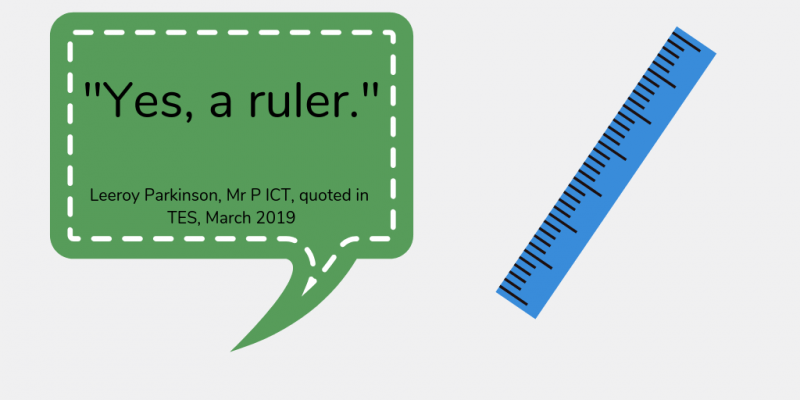
This is just one example of the potential Edtech has to go too far, trying to replace and improve upon something that did not need replacing or improving.
Using Edtech in schools often needs a more subtle and thoughtful approach, as has been outlined in the EEF Report.
Once problems have been identified, and solutions in the form of digital technology have been sought, it is crucial that schools train staff thoroughly on its use.
Further to this, teachers then need to ensure that digital technologies are supplementing the work that is already being done by engaging with what the children are doing whilst accessing the programme, making sure that any assessment data gathered is used to inform more traditional teaching methods.
Digital technologies have many fantastic benefits when used in the right way but we must not be fooled too easily into believing them to be the answer to all our of our existent or non-existent problems!
Further Reading
- The digital technology PDF from the EEF
- Buying the right edtech for your school – A guide from Educate and UCL
- Alive in the Swamp: Assessing digital innovations in education – A 2013 report from Nesta and Pearson
- Realising the potential of technology in education – A policy paper from the government on a strategy for education providers and the technology industry to help improve and increase the effective use of technology in education.
DO YOU HAVE STUDENTS WHO NEED MORE SUPPORT IN MATHS?
Every week Third Space Learning’s maths specialist tutors support thousands of students across hundreds of schools with weekly maths intervention programmes designed to plug gaps and boost progress.
Since 2013 these personalised one to one lessons have helped over 150,000 primary and secondary students become more confident, able mathematicians.
Learn about our experience with schools or request a personalised quote for your school to speak to us about your school’s needs and how we can help.

